Day 4 of our big 5 day Spring Bird Tour. It was rather cloudy for most of the day, but dry and with some brighter intervals. The wind had gone round and dropped, which meant it felt much milder than the last few days, which was most welcome.
After meeting in Wells, we headed off east along the coast today. A short diversion inland and we quickly located a Little Owl perched on the roof of a barn. It was a little distant from where we parked, but through the scope we had a good look at it. A Brown Hare ran past and a few Rooks were flying around the fields nearby.
We planned to spend part of the morning up on the Heath. As we got out of the car, we could hear Willow Warblers and Blackcaps singing. As we walked round the bushes, one of the Blackcaps perched up nicely for us in the top of a blackthorn. The lighter wind and warmer weather seemed to encourage the warblers to perform a bit better today.
 Blackcap – perched up nicely for us in a blackthorn
Blackcap – perched up nicely for us in a blackthorn
A little further round, we found a single Adder curled up under a gorse bush, sunning itself. It was not far from us but very well camouflaged. Unfortunately, by the time everyone had managed to see it, it had woken up and slithered away before the cameras were out.
The oak trees are starting to come into leaf and in one of them we could hear a pair of Long-tailed Tits calling. We stopped underneath and a Willow Warbler was singing in there too. We had a great look at them flitting around in the branches. The Willow Warbler found a caterpillar and stopped to beat it against a branch before gulping it down.
When we stopped to look at a Greenfinch in the top of some bushes, a small bird flew out and landed in the front below us, a Garden Warbler. When it turned, it looked very surprised to see us and shot back in, unfortunately before anyone had really had a chance to look at it. We waited a minute and could hear it calling agitatedly and eventually it started to work its way up into the top where we could see it. Then a second Garden Warbler appeared with it and the pair of them proceeded to look for food, hopping through the branches. It meant we got a great opportunity to look closely at this often rather elusive species.
There were several Yellowhammers singing as we walked round the Heath and we managed to get a good look at a couple of smart yellow-headed males. Linnets were everywhere – they seem to still do well on the heaths, even if they have declined sharply as a farmland bird. There was lots of activity here today, with Chiffchaffs and Common Whitethroats singing too.
As we walked round through the gorse, in full flower now leaving the Heath smelling of coconut, we heard a scratchy song away in the distance. A Dartford Warbler. We hurried round to the path on the other side, just in time to see it perched up on the top singing, though still some way away from us. It flew a short distance and landed on another gorse bush, giving another burst of scratchy song. It was hard to get onto, and it then flew down out of view, before all the group had seen it. We made our way over to where it had been and waited a while, hoping it would start singing again, but unfortunately it had gone quiet now.
We carried on round the Heath, enjoying all the birds singing, until we heard a brief snatch of Woodlark. It sounded like it might be some distance away, but one of the group spotted it perched in a dead gorse bush quite close to us. It stayed there for ages, seeming unconcerned by our presence, allowing us to get great views of it through the scope – we could see the bold supercilium, the two either side meeting in a shallow ‘v’ at the back of its neck, the rusty ear coverts and the distinctive black and white patch on the bend of the folded wing.
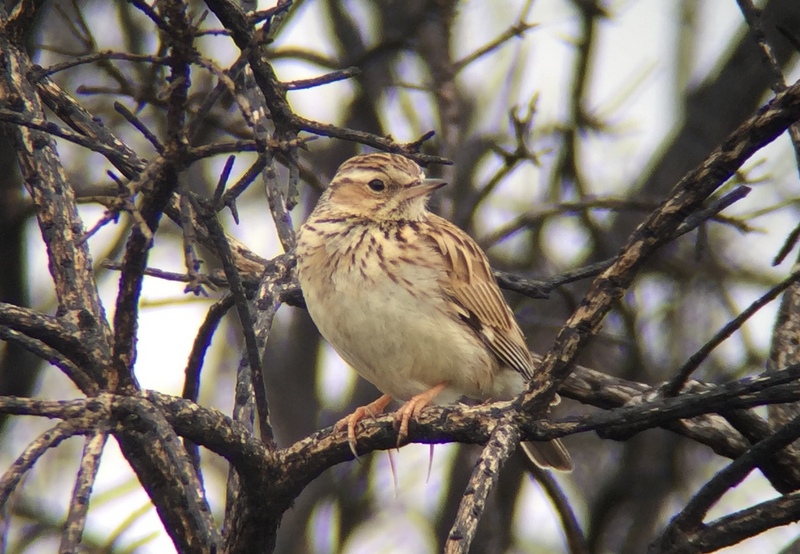 Woodlark – perched up very obligingly for us
Woodlark – perched up very obligingly for us
The Woodlark eventually took off and flew round calling before dropping down on the edge of the path the other side of us. We had to walk past that way, and it flew a short distance further in as we passed, landing again amongst some clods of earth, where it crouched down half hidden. As we left it in peace and carried on further along the path, a second Woodlark started calling and the flew up ahead of us.
When we got to one of the other areas favoured by the Dartford Warblers, there was a group of photographers standing around. They told us they had only had very brief views. We stopped along the path just past them and after a few minutes they wandered off. In no time at all, a male Dartford Warbler flew in and landed on the top of the gorse right next to us. Stunning views!
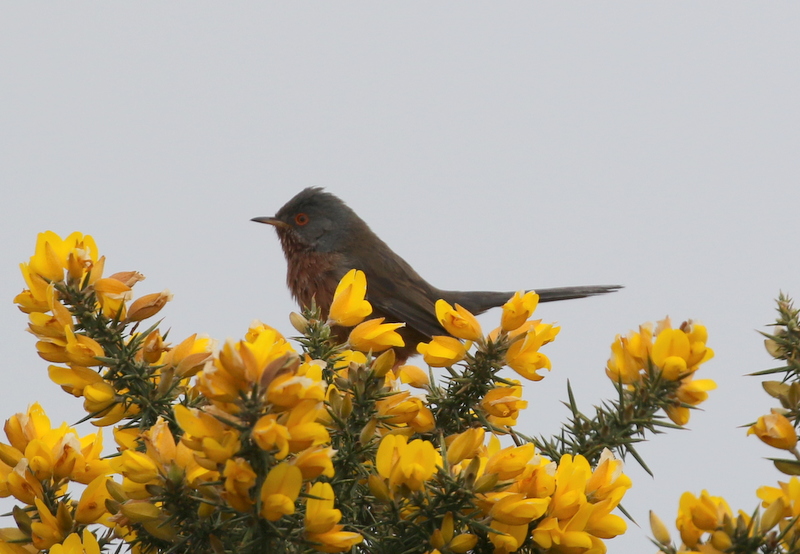 Dartford Warbler – this male flew in and landed in the gorse right next to us
Dartford Warbler – this male flew in and landed in the gorse right next to us
The male Dartford Warbler then flew across the path and landed on another bush the other side, perching there in full view for several seconds so we could all admire it, before dropping down the other side. A pair of Stonechats were feeding around the gorse just beyond. It was great to get such good views of the main target species here, so we decided to head back to the car.
There was still a bit of time before lunch, so we dropped down to the coast at Kelling and went for a walk along the lane down to the Quags. There were a few Blackcaps and Chiffchaffs singing in the hedges of the way down. We could hear a Lesser Whitethroat too, but it was across the other side of the field. A little further along, another Lesser Whitethroat was feeding quietly in the trees right next to the path.
At the corner of the Quags, a Sedge Warbler was singing from the brambles, occasionally flying up and parachuting back down in display flight. Just beyond it, we could hear a Grasshopper Warbler reeling too. Unfortunately, we couldn’t see the Grasshopper Warbler and as we edged down the lane, we realised that it was singing from the other side of the bushes. Still, it was nice to hear, a freshly arrived migrant and a good bird for this site these days.
We had thought there might be more visible migration today, with the wind finally having shifted round from the north, but the skies seemed rather quiet here. We did have a couple of single Yellow Wagtails fly over calling. We heard their loud ‘pseep’ calls as they approached but neither landed and both just continued straight over and off to the west. The cows are now being put on to the Water Meadows, but even that didn’t seem to be doing the trick in bringing them down.
There were a few ducks on the Water Meadows – a couple of pairs of Teal, a pair each of Shoveler and Gadwall – plus a single Mute Swan. As we continued along the track past the Water Meadows and down towards the beach, we spotted a wader flying in over the Quags. It was a Bar-tailed Godwit and it went down towards the pool. We walked back and it was feeding very actively along the edge of the water, clearly taking the opportunity for a quick refuelling stop on its way north.
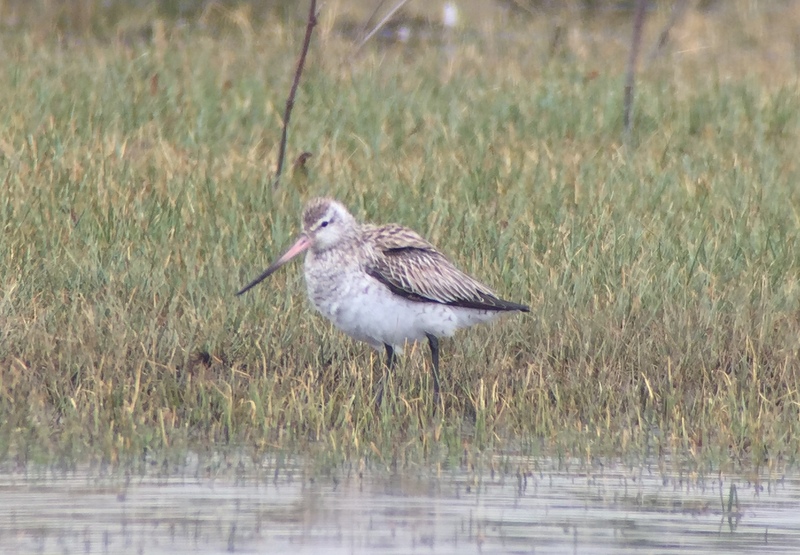 Bar-tailed Godwit – flew in and landed on the Water Meadow
Bar-tailed Godwit – flew in and landed on the Water Meadow
We had seen a distant Wheatear out on the Quags as we walked along, but when we got round there we found it had moved further over. There were now at least two Wheatears, feeding along the base of the shingle ridge. There were several Stonechats around the Quags too and a few Stock Doves flying around.
A quick walk up along the path along the edge of Weybourne Camp produced just a few more Linnets and Stonechats. Looking out to sea, we saw another two Bar-tailed Godwits flying past, they were obviously on the move today. A couple of Mediterranean Gulls flew west very high, but were very hard to see looking into the sun. The Weybourne Atmospheric Observatory caused the most amusement though – the pollution monitoring equipment there periodically emits four notes on a rising scale which is easily mistaken for a bird singing!
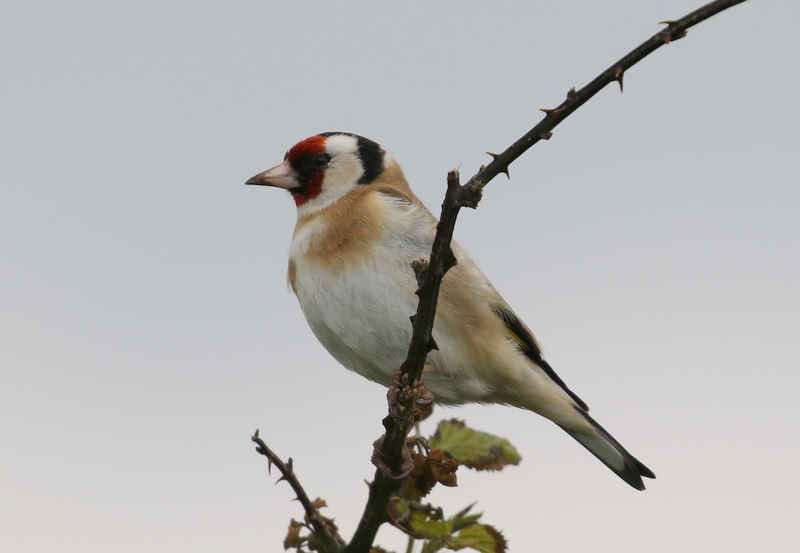 Goldfinch – several were around the Water Meadows
Goldfinch – several were around the Water Meadows
It was lunchtime now, so we made our way back to the car, flushing four Goldfinches up to the hedge that were feeding down on the path as we passed. Then we drove round to the visitor centre at Cley, where we ate our lunch on the picnic tables overlooking the marshes.
The main scrapes at Cley looked fairly empty, and there was very little reported up on the sightings board in the visitor centre, so we decided not to go out onto the reserve today. Instead, we headed round to the beach car park and walked out towards North Scrape. Looking out to sea, there were several Sandwich Terns flying back and forth and a single adult Gannet flew east some way offshore.
We had hoped their might be some migrants around the edge of the Eye Field, but there was nothing of note there today. The Blue-headed Wagtail which had been reported from North Scrape a little earlier had disappeared and there was very little else to see on here – just three Black-tailed Godwits, plus a pair of Avocets, a couple of Redshanks and a few Shelducks and Teal. We decided not to hang around and headed back to the car.
The walk out along the East Bank was more productive. Looking back towards Snipe’s Marsh as we set off, we could see two pairs of Common Pochard displaying, as well as several Tufted Ducks. We had very nice views of the Lapwings out on the grazing marshes, always stunning birds to look at. Several were displaying, and we watched their impressive tumbling flights and listened to their distinctive songs.
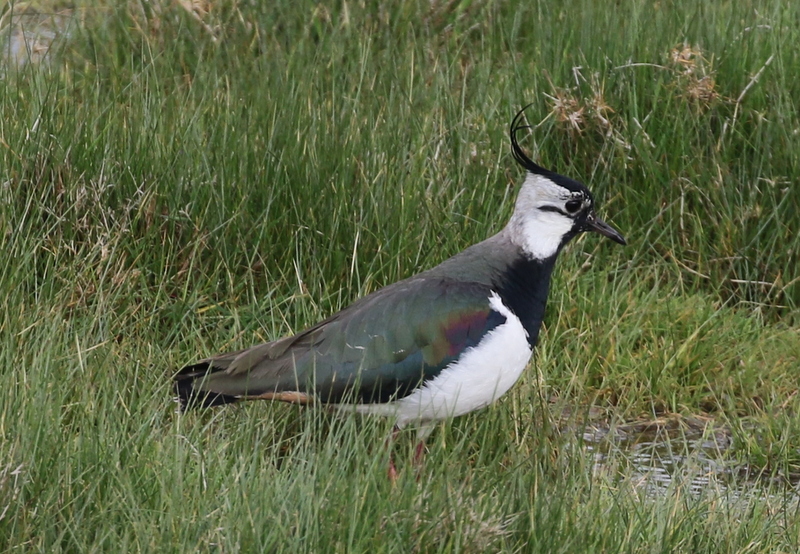 Lapwing – showing very well from the East Bank
Lapwing – showing very well from the East Bank
There was also a good selection of ducks out on the Serpentine and Pope’s Marsh, including several lingering Wigeon, plus a few Teal, Gadwall, Shoveler and Shelduck. A single Ruff and several Avocet were feeding around the pool at the back. Two Curlew flew high west over the bank, the first we have seen over the last few days. The two shorter billed Whimbrel which did the same sometime later have been more common.
Reed Warbler was a species we had heard several times in the last few days, but we had not yet managed to see one. We could hear a couple singing close to each other in the reeds just below the bank, so we stopped to try to see one. They were skulking in the reeds as usual, but eventually we managed to find both of them – one was singing from very low in the reeds, just above the water in the ditch, and the other was higher up but further back.
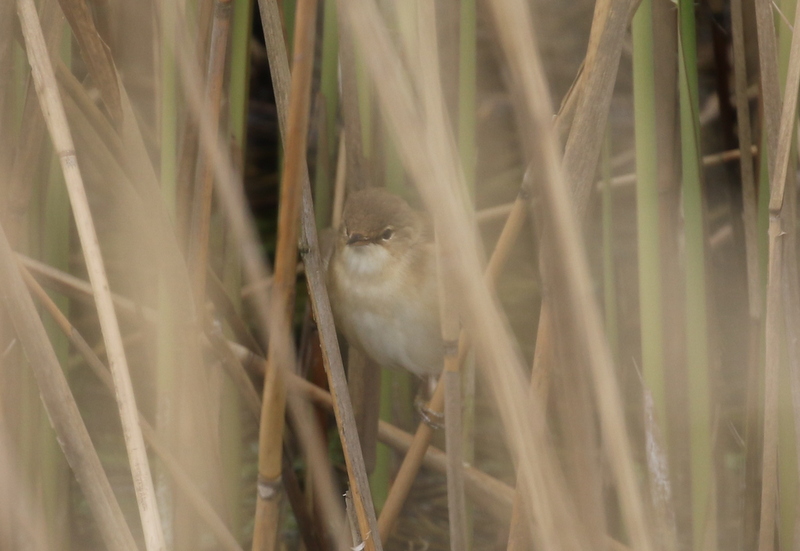 Reed Warbler – skulking down in the reeds, singing
Reed Warbler – skulking down in the reeds, singing
Looking out from the new shelter at Arnold’s Marsh, there didn’t seem to be a lot to see at first. A single Ringed Plover flew in and landed on one of the small islands and while we were looking at it in the scope we found several Dunlin creeping around in the saltmarsh behind. There were six Bar-tailed Godwits on here, including two in full summer plumage, with deep rusty underparts, the colour continuing right the way down under the tail. A good number of Redshanks were feeding around the edge of the saltmarsh and there were a couple of sleeping Avocets too.
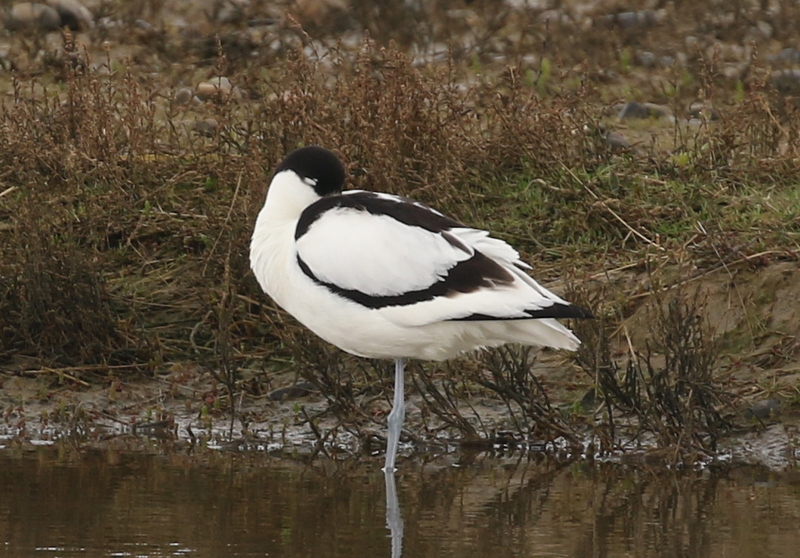 Avocet – one of a pair sleeping on Arnold’s Marsh
Avocet – one of a pair sleeping on Arnold’s Marsh
Continuing on to the beach, we couldn’t see a lot out to sea, apart from a lone Great Crested Grebe diving offshore. There were two smart male Wheatears on the grassy shingle ridge just to the east though, and we got one of them in the scope for a closer look.
As we started to make our way back, we noticed a small wader down on the mud on the grazing marsh below the bank. It was a Little Ringed Plover. Through the scope, we could see its bright yellow eyering, and also the more pointed dark bill and fleshy coloured legs which distinguish it from the Ringed Plover we had just seen a few minutes earlier.
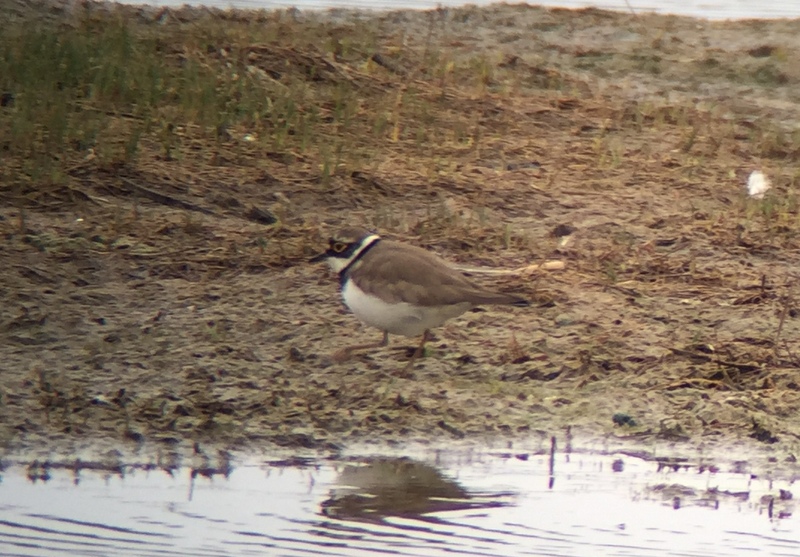 Little Ringed Plover – appeared on the grazing marsh on our way back
Little Ringed Plover – appeared on the grazing marsh on our way back
As we passed the reedbed, we could hear Bearded Tits calling. A female appeared briefly in the tops of the reeds further out, and we all had enough time to get onto it before it dropped down out of view. We thought that was good, but a couple of minutes later a male Bearded Tit flew in over the reeds and landed down on the edge of the ditch just behind us. We walked back and had stunning views of it as it picked its was along the ground or low through the bases of the reeds just above the water.
 Bearded Tit – we had great views of this male collecting insects along one of the ditches
Bearded Tit – we had great views of this male collecting insects along one of the ditches
The Bearded Tit seemed to be collecting insects, presumably to feed a hungry brood of nestlings somewhere out in the reeds. It worked its way down along the edge of the ditch for several minutes. Then presumably it had collected enough and it flew up and off over the reeds. A great way to end the day.
It was time for us to head back too. There were a few Marsh Harriers up now, circling over the reeds, and a small group of three Little Egrets heading back into the wood as we got back to the car.
















